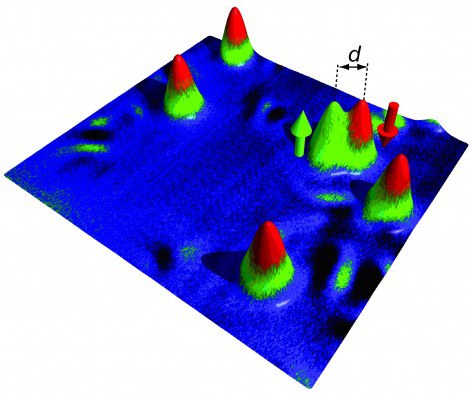Novel Magnetic Coupling Calculated and Measured in Detail
IFF-News March 04, 2010
If you bring two bar magnets together, you can feel the force of the magnetic field. In solids, electrons instead of fields can also transmit a force and thus align elementary bar magnets - so-called spins residing on magnetic atoms - relative to each other. In an article in "nature physics", scientists from Forschungszentrum Jülich and the University of Hamburg describe how this coupling between two magnetic atoms does not only depend on their distance, but to a large extent on the orientation of the magnetic dimer relative to the substrate lattice. This is due to the fact that the electrons in the crystal lattice disperse along preferred orbits. "For the very first time we have been able to determine the magnetic force an individual atom thus exerts on its immediate environment", explains Prof. Stefan Blügel, Director at the Jülich Institute of Solid State Research (IFF-1) of "Quantum Theory of Materials". His team used the supercomputer JUGENE at Forschungszentrum Jülich to simulate the behaviour of individual cobalt atoms on a platinum surface. The RKKY effect - named after four theorists Rudermann, Kittel, Kasuya and Yosida - plays a pivotal role here. The electrons in the platinum align their spins parallel or antiparallel to the spin of a central cobalt atom. Other cobalt atoms then orient themselves relative to this direction. Due to the quantum-mechanical rules that apply for the lattice system, this results in both parallel and anti-parallel alignments, depending on the distance and orientation of the atoms involved.
The calculations made at Jülich were confirmed by scientists at the University of Hamburg by measurements using a special scanning tunnelling microscope. With the help of this new detailed knowledge of the RKKY coupling, customized magnetic structures can be created on an atomic level. Such systems will help to develop novel components for chips by exploiting the atomic spin, and may thus be the basis for the computers of tomorrow.


Original publication:
Nature physics - doi:10.1038/nphys1514
Institutes:
IFF-1 "Quanten-Theorie der Materialien"
Institute for Advanced Simulation (IAS)
